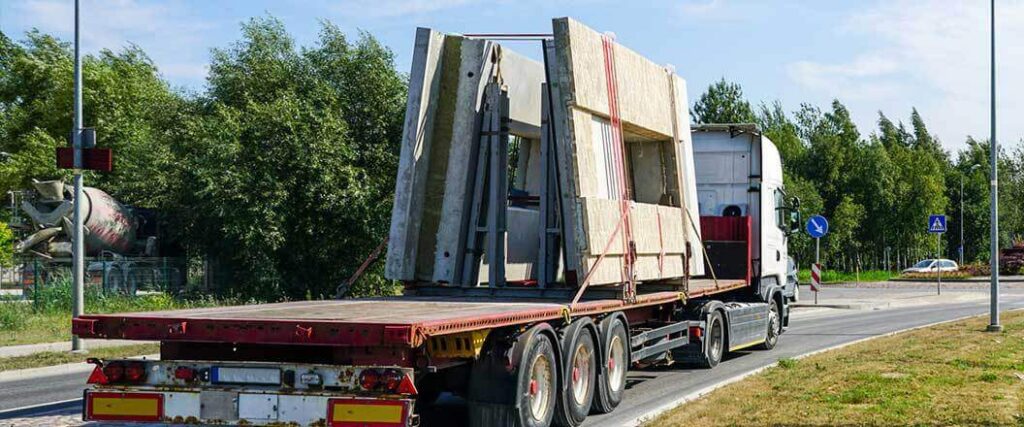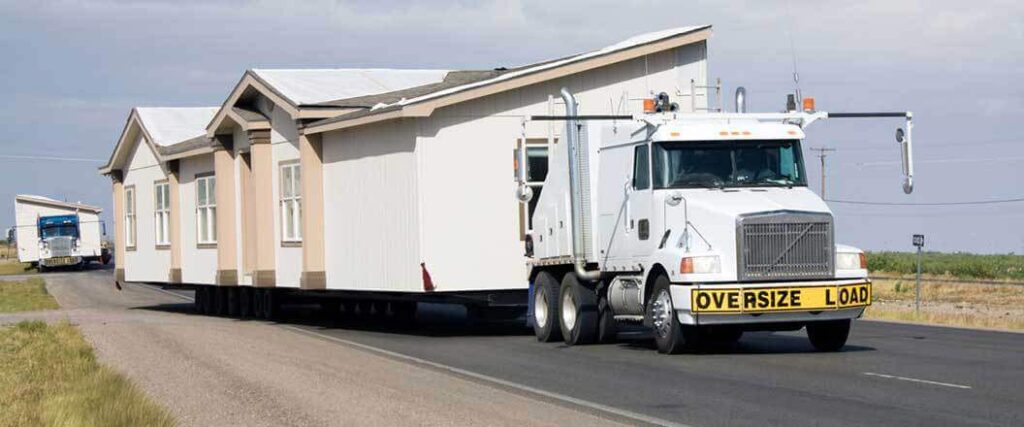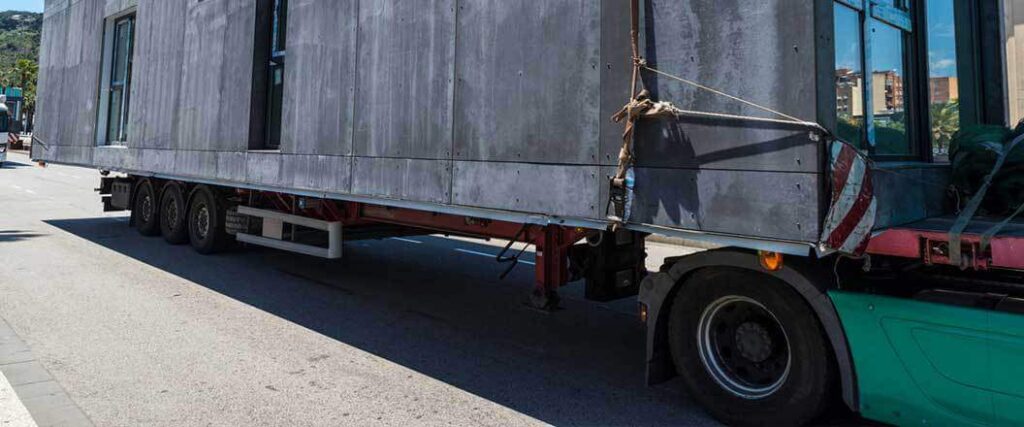Modular building transport is becoming a much needed service for many construction companies. Prefabricated buildings are increasing in popularity because they can be used for a variety of purposes. As their popularity grows, the demand for services to transport them has grown as well.
According to Alternative Building Solutions, modular buildings are oversize. Therefore, modular building transport can only be performed if oversize permits are provided and if the load travels on a viable route. Shippers should also recognize that multiple shipments are needed to get all modular buildings to the construction site.
Modular building transport places a great deal of responsibility on shippers. Fortunately, we’ll show you what needs to be done for this service to be performed successfully.

Modular buildings are a type of structure that’s manufactured in sections. The manufacturing process occurs mostly in a factory environment. Once the sections are completed, they’re transported to the construction site where they’re assembled..
The parts that make a modular building includes:
Modular buildings can be assembled into many configurations once at the construction site. Each module can be stacked on top of another or each end can be attached to another. The way each module is combined depends on the type of building each module is supposed to form.
There are:
Regardless of what type of modular building is being transported, it must be handled with care and all applicable regulations will need to be followed. Modular buildings have grown in popularity and are likely to be constructed more frequently in the future.
| Building Types | Number of Buildings |
| Healthcare Facilities | 82 |
| Hotels and Motels | 74 |
| Multifamily | 71 |
| College Building and Dormitories | 70 |
| Offices Low-Rise (1-4) | 58 |
Provided by Statista
The lifespan of modular buildings depends on whether it was meant to be temporary or permanent. Temporary, or relocatable, modular buildings are transported to a location when needed temporarily, like for disaster relief, temporary housing for workers, medical clinics or construction site offices. Once these buildings serve their purpose, they can be easily moved to the next location.
The permanent modular buildings can last just as long as traditional buildings; some lasting between 25- 30 years. Permanent Modular Construction (PMC) involves the use of building material such as concrete, steel, and other materials that would give it a more durable structure. Additional features are then installed on-site. The PMCs aim at remaining in one location once they are built and can have as many storeys added onto it.
Regardless of whether it’s used as a permanent or temporary structure, modular building movers will be in more demand as these structures are increasingly used for different purposes.
Need to ship a greenhouse? Check out our article on how to transport the structure correctly.

Most modular buildings are considered oversized freight. This means that they exceed the legal weight and dimensions of the state(s) that it’s traveling through. Transporting oversized freight will require shippers and carriers to follow numerous regulations.
Some of these regulations include:
Regulations for oversized shipments will vary by state. That means if a modular home is traveling through multiple states, shippers and carriers have to abide by the regulations in each one. Certain states also have differing regulations regarding what days and times oversized freight is permitted to be transported through the state. These runtime regulations may also place holiday restrictions for oversize loads.
It’s likely that a special route will have to be planned for a shipment. The reason for this is that modular buildings are too large to travel down certain roads. Routes that have bridges that don’t have enough clearance for oversized freight to travel under. Roads with sharp turns could imbalance the entire shipment.
Read our article on heavy haul shipping regulations if you want to learn about the requirements that must be followed when shipping this type of freight.

Most modular building shipments are considered oversized. Therefore, many preparations need to be taken before shipping can commence. Many of the preparations are legal requirements, while others are safety practices.
These preparations include:
These preparations ensure that shipments of modular buildings will arrive safely at the final destination.
Modular building transport can only be performed if a permit is provided for the shipment. Not only will a permit be required for each state the shipment travels through, local permits might be required as well. Local oversized permits are for roads owned by counties or townships.
Most state Departments of Transportation (DOT) require shippers and carriers to make an account. These online accounts allow shippers and carriers to apply for oversized load permits. Local entities require shippers and carriers to set up online accounts to obtain oversized permits.
Permits will require specific details about modular building loads and the equipment/vehicle that will be used to transport it. The exact information might slightly vary based on state and local entity, but most information will be the same.
Modular building parts are wrapped with protective materials before being transported. These materials help keep the parts clean and resistant to various weather conditions. Specialized shrink wrap is more expensive, but can be wrapped around each part of a modular building much more easily. Shrink wrap has become the more popular material due to it being easier to wrap and its durability.
Shrink wrap can be placed on the outside a modular home by following these steps:
Modular building parts will be ready for loading once shrink wrap has been secured to them.

Our excellent network of modular building movers can transport your oversize shipment anywhere in the country! Get a fast, personalized quote.
Cranes are used to pick up modular buildings onto the vehicle and equipment used for transportation. A scissor lift may also be needed if you need to secure the top of the structure.
The loading process is a simple, but dangerous task to complete. The slightest mistake could cause serious injury to workers and property around the loading area.
Therefore, workers must complete loading very carefully to avoid any costly mistakes. Safety is maintained by performing this procedure in an area where there’s plenty of space. Workers also keep a good distance away from the modular building as it’s being hoisted by a crane. This prevents them from getting injured in case the modular building comes loose from the crane and falls.
Modular buildings that have been loaded onto a flatbed or a chassis will have to be secured. While modular buildings are large and heavy, they can still shift while they’re being transported. Securing these loads will keep them and other drivers on the road safe.
Modular homes are secured to the equipment used to transport them with chains and straps. This equipment is used to connect the frame of the modular building to the trailer or chassis. Once secured, the shipment is ready for its journey.
Read our article to learn how to transport a fiberglass pool.
Modular building transport is often performed using commercial trucking services. Commercial trucks can be outfitted with an assortment of different trailers and equipment that are capable of carrying different parts of a modular building. The type of trailer or equipment used to haul each part will vary based on the size of each module.
That said, a truck will transport a modular building using one of the following:
Modular buildings that are transported using a chassis are actually integrated into the chassis itself. Flatbed trailers can be used when moving modular buildings as well. The benefit of flatbed trailers is that they come in different dimensions and designs that can accommodate modular building parts of varying sizes.
Even with the use of chassis and flatbed trailers, it’s unlikely that all the parts of a modular building can be transported at once. Therefore, multiple shipments will have to be performed to get each building module to the construction site.
Once the modules are transported to the on-site location, the unloading process begins. Individual components are lifted off the truck using a crane. Depending on the foundation laid, the modular building may be permanent or temporary.
If there is an on-grade foundation is for permanent modular buildings while a raised foundation could be for either a permanent or temporary modular foundation. The crane places the transported modules and arranges them in accordance with the design plan.

Modular building transport services can cost anywhere between $5,000 and $15,000. The cost of transporting a modular building varies as it depends on factors such as load size, distance, and so on. The best way to determine the price is by getting a freight quote. Since a freight quote helps you in determining the cost, it must be calculated accurately.
There are several factors are to be considered when calculating the freight rate; these include:
The number of trucks available and where they are would also affect the freight rate. If a shipper requires four trucks to transport modular buildings, but there are only three trucks available, there might be a need for one truck to either incur more load or repeat the journey. The location of the vehicle at the time a shipper requests it may also affect the price.
Shipping rates can also rise if the area of on-site location has restricted access. Longer distances may add more to the freight rate than that of shorter distances because of the cost of fuel.
Read our article to learn how to transport a mobile home.
Oversize & Heavy Haul can take care of all your modular building transport needs. We have a network of numerous modular building movers that can transport your oversize shipment anywhere in the country. Many of the carriers we’ve partnered with can transport these buildings with a variety of trailers.
These trailers include:
Regardless of the size of your modular building, we guarantee that one of our carriers will be able to transport it for you. If you’re ready to take advantage of our heavy haul operator, then fill out your quote. You can also contact one of our team members at (855) 490-2433 for more information about our services.
Heavy Haul and Oversized
315 NE 14th Street #4122
Ocala, FL 34470
I have a client that would like to relocate (7) 12x60 modular classroom units from Perris, CA to Moreno Valley, CA. Can you provide a cost estimate?
Hi, Kathy! I have sent your contact information to one of our freight experts. We'll be in touch soon!
Hello,
I am a graduate student from Clemson University, and I am researching modular construction and its project performance for my thesis. I am just working on transportation in modular construction and wanted to know what types of vehicle sizes you used for transportation, their fuel consumption rate, and the cost required for transporting these modules per mile. Also, can I get an estimate for the overall cost of transporting the module to the site for a single mile?
This information would be beneficial for me. Please let me know if you need any more information from me.